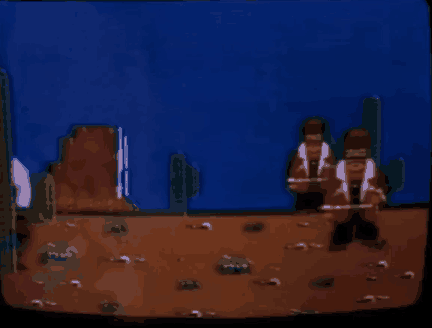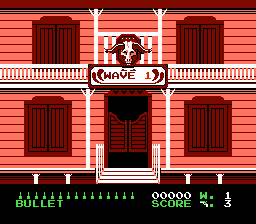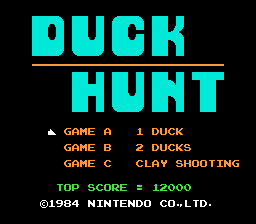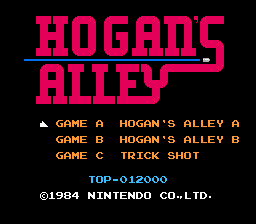I've been playing a lot of Point Blank lately with my newly-arrived Sinden Lightguns. The configuration software could stand some improvement from a usability and aesthetics perspective - it looks like a Visual Basic 6 program, and you do need to interact with it a bit before playing, but all of that is easily forgotten once the gameplay starts proper. The guns feel solid and accurate, and are compatible with my 4K LCD without needing any sort of external tracking devices like its competitors do. I did feel a bit apprehensive at first, as the cursor did follow where I was pointing, but was extremely jittery, and I played around with settings a lot, but it turned out all I really needed to do was turn on a patterned screen border, which I found stabilized things nicely when I set it to be 2% of the screen width and otherwise used its default settings. It didn't even need calibration - the gun just knows where it's aiming at, and unlike guns that that rely on IR tracking, it doesn't need an onscreen reticle to show you where you're aiming. You can aim with your wrist, you can aim moving the gun laterally as you keep the barrel level and perpendicular to the screen (or not), and it just works.
One downside is that the Sinden Lightgun will not work if it's too close to the screen. The documentation recommends being 2.5 times as far from it as the screen is wide. So no cheating by putting the gun right up next to the picture tube.
Of course, this post isn't about Point Blank, but is specifically about what I call Nintendo's Zapper Trilogy - three light gun shooters which debuted on the Famicom in 1984, and saw stateside release for the NES in October 1985. I used iron (plastic, rather) sights for all of these games, as you would in the 80's, with the only additional bit of aiming feedback a crosshair that appears after shooting, simply because these games wouldn't be very interesting to watch on emulator footage otherwise.
As these games are pretty basic, and don't lend themselves well to a lot of words, I'm going to cover them all in one post.
Game 316: Wild Gunman
The first Zapper game, a callback to one of Nintendo's earliest arcade games, was first released in Japan in February 18th, 1984.
First of all, this is what the original Japanese Famicom Gun looked like:
 |
| Photo from an eBay auction |
Like many other early Nintendo games, a trend we saw as early as 1978's Block Fever, there are three game modes to pick from. I played them all, briefly.
Game A, like the 1974 FMV arcade game, squares you off against a series of increasingly quick gunslingers, and they're polite enough to indicate ahead of time exactly how much time you've got to outdraw them. Fire before their eyes light up, and it's a foul, you lose a life.
Weirdly, this mode doesn't really care what you're aiming at. As long as you're pointing the gun at the screen, it will register as a hit. This makes the game much too easy, so I challenged myself by forcing myself to keep the gun held at my hip pointed down, quickdrawing once I heard "fire."
It's not challenging or interesting, but I'll at least say that the presentation is decent enough. The graphics are pretty good for the era, with big, detailed, cartoony sprites, and the 'fire!' voice sample is adequately clear. "D" found the animations pretty amusing. "One guy gets his pants shot off, another gets his hat shot off, and another just dies!"
Game B gives you two opponents at a time and is much more challenging.
You still don't need to aim with precision - hitting the half of the screen with your target is good enough - but now you've got to shoot twice. Or not, as sometimes they'll trick you by only having one gunman draw, and if you shoot at the one who didn't, it's a foul. Having the faster gunman not draw is a dirty trick that Game B will pull on you when you least expect it.
Lastly, there's Game C, a free-for-all shootout at the saloon.
It's basically whack-a-mole with a Western setting. A little more aiming precision is needed here, but not that much. If you shoot anywhere near the window or door where a gangster pops up, it's a hit. This was my favorite mode by a wide margin. That said,
GAB rating: Below average. Wild Gunman was the least popular of the 1984 Zapper games, and it isn't very substantial, or very good. It's not even satisfactory as an introductory Zapper game, because it barely involves aiming. Nintendo would release a better and more successful one soon after.
Contrary to some lists, Wild Gunman was never enhanced and released for the Nintendo VS. System arcade board, as multiple early Famicom titles were. The only arcade outing it saw, apart from the 1974 original, was on the later PlayChoice-10 system, featuring no meaningful differences from the Famicom cartridge. Though in 1989, a faux prop version did appear in a certain famous movie.
 |
| No, there's no way to play it. |
Game 317: Duck Hunt
Now we're talking. The ducks. The clay pigeons. That damned dog laughing at you when you miss. Duck Hunt is iconic, synonymous with the very Zapper peripheral needed to play it.
Duck Hunt was first released in Japan in April 21, 1984, and could possibly be based on a toy that Nintendo released in 1976, which itself uses a miniaturized version of the technology found in Laser Clay Shooting System, their first electro-mechanical arcade game.
Like many of my readers, I'm sure, the Super Mario Bros. / Duck Hunt cartridge came bundled with my NES back when I had one, and Duck Hunt is the only one of these initial Zapper games that I played on it.
Game A releases ten ducks, one at a time, and gives you three shots at each. Bag six of them and you move up a round, miss five and you lose. It's much too easy and pretty boring, to be honest, and though "D" and I had some fun taking turns, I didn't bother recording any footage of playing it. Instead, the below video starts with Game B, which releases two at a time and still only gives you three shots at each pair.
If you want something non-violent, Game C offers clay pigeons to shoot, in what I'm pretty sure is supposed to be a callback to the original Laser Clay Shooting System / Mini Laser Clay. They're faster, smaller targets than the ducks, but I think this mode is overall easier than B, as they're predictable. The easiest time to hit them is at the peak of their parabolic trajectories, though depending on how rapidly the targets are released, it might not be possible to hit both this way. Here, after a perfect round 6, I failed on round 7, partly because of a difficulty spike, but also because my arm was getting tired.
GAB rating: Above average. Duck Hunt's a classic, and this was fun in short doses, but I'd rather be playing Point Blank. "D" disagrees and insists I note that she'd give have given it a "good" rating.
Duck Hunt, unlike Wild Gunman, did get a genuine arcade release in Nintendo's "VS." series. In fact, this was the game's first release in the US, predating the NES's launch by several months. There's no game selection, but instead, rounds alternate between Game B and Game C. It's made more difficult than the Famicom game, with ducks that fly faster and more randomly, and clay pigeons that come out simultaneously. Every missed target docks you a life too, you're only afforded five, and I'm quite positive that the aiming is bugged, though this could also be an emulation problem.
The real bonus, though, is the newly added bonus round that follows even-numbered rounds. Here, at last, you can shoot the dog.
Game 318: Hogan's Alley
The term Hogan's Alley, which originates from an 1890's newspaper comic, refers to any number of police training facilities where exercises are performed in a simulated urban environment. This game, the third Zapper title, came out in Japan in June 12, 1984, and offers three marksmanship games based around this theme.
Of the three Famicom Zapper games of 1984, this one certainly offers the most variety. I played and recorded all three in a session for the video below.
Game A is a shooting range. Three targets pop up, and you must quickly identify the gangster (or gangsters) and shoot. Do not shoot the innocents. Or the cops.
You're allowed ten mistakes before the game ends, and when you have less than a second to shoot two targets, it's nearly impossible to get both. But this is still the easiest mode, and also the most boring, and feels like practice for Game B.
Here, we have a run through the titular alley, shooting at pop-up targets and avoiding the occasional bystander. I had some trouble with not shooting the professor, as I'd often mistake him for the red-haired criminal in the very brief duration you're given to recognize him. It's overall reminiscent of Wild Guman's gang mode, but more difficult, and more fun.
Lastly, Game C has you plinking at tin cans in the air, trying to land them on ledges. If nothing else, it's different from anything before it.
Shooting these small targets into their cubbies takes both skill and strategy, especially if you're going for a good score, as the bottom hole is worth a whopping 5,000 points compared to the next one up of only 800! But it's the most difficult and risky one to aim for, so my strategy became to not worry about points until there's only one can left, and focus on getting the bonus with that one. As with the other games, ten misses loses the game.
GAB rating: Average. Hogan's Alley is the hardest of the Zapper trilogy, and offers more variety than Duck Hunt, but it isn't as much fun. It's also the blandest looking, with its unanimated cutout targets and equally cardboard-looking environments. The challenge and variety does place it a bit above Wild Gunman in my book, though "D" once again disagrees and would rate them the same.
Nintendo released a Vs. Hogan's Alley too, but there's nothing special about it. It's a bit faster than the Famicom game, you only get five misses, and the rounds cycle through all three game modes without having any kind of exclusive bonus round.
This excursion into the past was fun and somewhat nostalgic, as the Duck Hunt was the only Zapper game I ever owned, but even then it didn't hold my attention for very long when I could play Super Mario Bros instead just by hitting the reset button, and none of these launch Zapper games held my attention long in 2022 either. The Sinden Lightgun is a cool product, still, and thankfully works with so much more than old Zapper games. Speaking of which, I'm going to go play some more Point Blank (curse those impossible "very hard" stages!).





















Ah, a Smash debut
ReplyDeleteAbout time someone got a period-specific controller! The CRPG Addict won't even buy a gamepad for action RPGs.
ReplyDeleteBut holy moly, £85 for that thing. Yikes. And that's for the one without recoil, and you really want the recoil. And there's a foot pedal too, for Time Crisis.
I bought a two pack with recoil. Expensive but worth it. The $260 footpedal, though, is crazy. I like Time Crisis, but not that much. Plus I could just get a plastic one on eBay for twenty bucks.
DeleteI still have the nintendo powerglove kicking around somewhere...
ReplyDelete